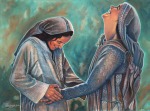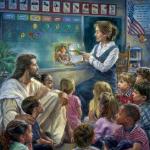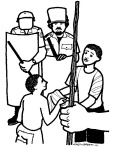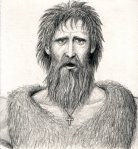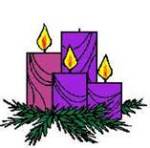2nd Sunday of Ordinary Time
T oday’s Content:
oday’s Content:
- · Dan’s Deliberations, Discoveries, & Declarations
- · Quote of the Day
- · Today’s Gospel Reading
- · Gospel Reflection
- · Reflection Prayer
ТТТ
Dan’s Deliberations, Discoveris, & Declarations:
Please let me explain why I did not publish a blog Wednesday. I have a chronic eye condition known in the medical field as “keratoconus”. Patients with this condition have misshaped globes of the eye. Instead of the c
orneas being round and smooth, my eyes are shaped like the ends of footballs, and with ridges on their surfaces. Thus, I wear specially made (very expensive) contacts in order to see well enough for daily living. Without these contacts, my vision is like looking through a very thin layer of petroleum jelly. Eventually, I will have to have corneal transport surgery on both eyes, but obviously, I wish to postpone this surgery as long as is reasonable.
One of my eyes has started to develop blood vessels on the cornea; some
thing very bad for future corneal transplant surgery. Thus, I have to use four different medications on the eye throughout the day and night, and I am unable to wear a contact in this eye until some point after my surgery. Laser surgery is scheduled for late February (He will burn the blood vessels on my cornea with the laser).
For now, it is difficult to read due to the resultant blurriness of not wearing the contact. For this reason, I have to limit my reflection blog to Sundays – – only FOR NOW. I am also asking for your prayers in this matter. Thank you in advance.
ТТТ
Quote of the Day:
“To turn water into wine, and what is common into what is holy, is indeed the glory of Christianity.” ~ Frederick William Robertson
ТТТ
Today’s reflection: Jesus performs his first sign at a wedding feast in Cana. Jesus heard and obeyed His mother, Mary – – the mother of God; Do YOU?!
(NAB John 2:1-11) 1On the third day there was a wedding in Cana in Galilee, and the mother of Jesus was there. 2 Jesus and his disciples were also invited to the wedding. 3 When the wine ran short, the mother of Jesus said to him, “They have no wine.” 4 [And] Jesus said to her, “Woman, how does your concern affect me? My hour has not yet come.” 5 His mother said to the servers, “Do whatever he tells you.” 6 Now there were six stone water jars there for Jewish ceremonial washings, each holding twenty to thirty gallons. 7 Jesus told them, “Fill the jars with water.” So they filled them to the brim. 8 Then he told them, “Draw some out now and take it to the headwaiter.” So they took it. 9 And when the headwaiter tasted the water that had become wine, without knowing where it came from (although the servers who had drawn the water knew), the headwaiter called the bridegroom 10 and said to him, “Everyone serves good wine first, and then when people have drunk freely, an inferior one; but you have kept the good wine until now.” 11 Jesus did this as the beginning of his signs * in Cana in Galilee and so revealed his glory, and his disciples began to believe in him.
ТТТ
Gos pel Reflection:
pel Reflection:
This Sunday we begin the liturgical season of Ordinary Time. For many Sundays in this lectionary cycle (Cycle C), our readings will be taken from the Gospel of Luke. Occasionally, however, we will read from John’s Gospel [as we do in every lectionary cycle]. Today’s Gospel reading comes from John, describing the beginning of Jesus’ public ministry and His first miracle – – His first “sign”.
To situate today’s reading within the context of John’s Gospel, we need to know that this event follows Jesus’ call of His first six disciples (cf., John 1:35-51). John tells us that Jesus and His disciples were invited to this wedding at Cana, along with Jesus’ mother, Mary. This event is unique to John’s Gospel. There are no parallel reports of this miraculous “sign” at Cana in any of the Synoptic Gospels.
Today’s Gospel is about “Signs” (“sēmeion” in Greek). John uses “signs” to re veal Jesus as the true promised Messiah to ALL “Israel”. John uses “signs” to symbolize Jesus’ wondrous actions, His deeds. We need to remember that the Gospel according to John is quite different in character from Matthew, Mark, and Luke. His writing style is highly literate and symbolic in nature. It does not follow the same order, nor reproduce the same stories, as the other three Gospels. To a much greater degree as that of the three other Gospel writers, it is the product of a theological reflection growing out of a different circle of readers, and their different traditions. John’s Gospel was probably written in Ephesus during 90’s AD.
veal Jesus as the true promised Messiah to ALL “Israel”. John uses “signs” to symbolize Jesus’ wondrous actions, His deeds. We need to remember that the Gospel according to John is quite different in character from Matthew, Mark, and Luke. His writing style is highly literate and symbolic in nature. It does not follow the same order, nor reproduce the same stories, as the other three Gospels. To a much greater degree as that of the three other Gospel writers, it is the product of a theological reflection growing out of a different circle of readers, and their different traditions. John’s Gospel was probably written in Ephesus during 90’s AD.
John’s Gospel narrative contains a series of “signs”, seven to be exact (They will be listed near the end of this reflection.). John’s Gospel’s relates God’s “Word” through a series of wondrous deeds – – actions – – by Jesus Himself. It gives the impression that John is primarily interested in the “significance” of these actions.
The first sign in today’s Gospel reading, is the “transformation of water into wine” at a wedding feast in a place called Cana (John 2:1 –11). This first “sign” represents the replacement of the Jewish ceremonial washings (John 2:6), and symbolizes the entire creative and transforming work of Jesus then, and still today. He is still actually transforming US ALL through our hearing of His “Word” and the fellowships of our Church’s seven Sacraments.
–11). This first “sign” represents the replacement of the Jewish ceremonial washings (John 2:6), and symbolizes the entire creative and transforming work of Jesus then, and still today. He is still actually transforming US ALL through our hearing of His “Word” and the fellowships of our Church’s seven Sacraments.
So, the Old Testament exodus stories provide the background for today’s reading:
“Recall today that it was not your children, who have neither known nor seen the discipline of the LORD, your God—His greatness, His strong hand and outstretched arm; the signs and deeds He wrought in the midst of Egypt, on Pharaoh, king of Egypt, and on all his land; what He did to the Egyptian army and to their horses and chariots, engulfing them in the waters of the Red Sea as they pursued you, so that the LORD destroyed them even to this day … Moses summoned all Israel and said to them, You have seen with your own eyes all that the LORD did in the land of Egypt to Pharaoh and all His servants and to all His land” (Deuteronomy 11:2-4; 29:1-2).
God’s intervention in human history is anew again – – in a new, fulfilled, and fulfilling way – – through Jesus Christ in the midst of His brethren today.
T
The first verse talks about Jesus being in a place called “Cana”:
“On the third day there was a wedding in Cana in Galilee, and the mother of Jesus was there” (NAB John 2:1-11).
Cana is NEVER mentioned in the Old Testament. The only other (two) biblical references to “Cana” can be found(1) in John 4:46, which mentions Jesus, while in “Cana”, being asked to heal the son of a royal official at Capernaum; and (2) in John 21:2, where the Apostle Nathanael (Bartholomew in the Synoptic Gospels’) comes from “Cana”. Cana of Galilee is not mentioned in any other book of the Bible, or in any other contemporary literary source. So where is “Cana”, and why is this place significant to John? I do not know with certainly. Speculation is rampant among bible scholars, but I would love to find this place someday when finally discovered with certainty. I hear the wine there is truly divine!
Also in the first verse, “The mother of Jesus” is never mentioned by name. Matter of fact, Mary is never mentioned by name in John’s Gospel. And, on t op of this, Joseph is not present at the wedding feast as well. I suspect Jesus’ earthly “father” had died sometime between his finding his lost Son in the Temple and this event some eighteen years later.
op of this, Joseph is not present at the wedding feast as well. I suspect Jesus’ earthly “father” had died sometime between his finding his lost Son in the Temple and this event some eighteen years later.
Jesus, per John, addressed His mother by saying “Woman”:
“Woman, how does your concern affect me? My hour has not yet come” (John 2:4).
This was NOT a ‘diss (slang word for “treat with contempt”) on Mary!! Today, a child would possibly be given the “ev il eye” for calling his/her mother “woman” in this way. However, in actuality, this was a normal and POLITE form of addressing one’s mother during Jesus’ time. He also calls her by this SAME title while dying on the Holy Cross, at His most intimate – – and final – – time with her:
il eye” for calling his/her mother “woman” in this way. However, in actuality, this was a normal and POLITE form of addressing one’s mother during Jesus’ time. He also calls her by this SAME title while dying on the Holy Cross, at His most intimate – – and final – – time with her:
“When Jesus saw His mother and the disciple there whom He loved, He said to His mother, ‘Woman, behold, your son’” (John 19:26).
The word “woman” was a revealed word which was highly exulted (like the word “king”) amoung the Jewish peoples. Jesus is “the Word made Flesh”. When Jesus Christ calls His mother “woman”, He is revealing the promised fulfillment in Genesis:
“I will put enmity between you and the woman, and between your offspring and hers; They will strike at your head, while you strike at their heel” (Genesis 3:15).
T
Wine was running low, a good “sign” of the celebration being in full force, but a bad sign because – – they are RUNNING OUT OF WINE! So, Mary, probably helping at the celebration, goes to her son and says:
“When the wine ran short, the mother of Jesus said to him, “They have no wine” (John 2:3).
Jesus replies to “His mother”:
“Woman, how does your concern affect me? My hour has not yet come” (John 2:4).
If it “wasn’t His time”, why did Jesus do what His mother asked? After all, Jesus never worked miracles solely to help His family and friends. I believe He performed this first miraculous “sign” out of OBEDIENCE to His mother,  knowing the importance of [what we today know as] the Fourth Commandment and its great importance in God’s kingdom:
knowing the importance of [what we today know as] the Fourth Commandment and its great importance in God’s kingdom:
“Honor your father and your mother, that you may have a long life in the land the LORD your God is giving you … Take to heart these words which I command you today… Bind them on your arm as a ‘sign’ and let them be as a pendant on your forehead” (Exodus 20:12; Deuteronomy 6:6, 8)
I wish people today saw and appreciated the need and JOY to be obedient to God’s Commandments, and not to subjugate them – – to de-prioritize them – – out of personally selfish wants and desires.
Now, let’s go on to discuss the second (of three) points about His reply to His “mother”:
“How does your concern affect me?” (John 2:4)
Everything Jesus says is a fulfillment of Holy Scripture. He is telling His mother that if He does what she implies, the “cats are ‘g onna be out of the bag”! Mary is hastening God’s will, My source and My authority by doing a miracle to meet the wedding parties need. That’s why, I believe, the third revealing point in this one verse relates to Jesus saying:
onna be out of the bag”! Mary is hastening God’s will, My source and My authority by doing a miracle to meet the wedding parties need. That’s why, I believe, the third revealing point in this one verse relates to Jesus saying:
“My hour has not yet come” (John 2:4).
The “hour”, I believe Jesus is referring to, is His Passion, death, resurrection, and ascension to heaven:
“Before the feast of Passover, Jesus knew that His hour had come to pass from this world to the Father. He loved His own in the world and He loved them to the end” (John 13:1).
I wonder how much Jesus knew about His future at the time of the wedding feast miracle. Did He know every single detail about His gruesome torture and death to come? Did He know the beauty He will find in His ascension? I believe He did. Do you? However, Jesus was focusing on His mother’s concern for the wedding couple. He moved up the clock, revealing His divine authority. So, He begins a series of seven signs here at “Cana”.
Only after John has Jesus fulfilling these seven “signs”, does the “hour” of Jesus fully arrive. The whole Gospel of John is a progressiv e “revelation” – – a REVEALING – – of the glory of God’s only begotten Son. At “Cana”, Jesus is beginning to reveal God the Father fully; which will ne fulfilled later when He returns – – in “glory” – – to His heavenly Father on our behalf. Jesus did this as the beginning of His signs in Cana in Galilee and so revealed His glory, and His disciples began to believe in Him” (John 2:11).
e “revelation” – – a REVEALING – – of the glory of God’s only begotten Son. At “Cana”, Jesus is beginning to reveal God the Father fully; which will ne fulfilled later when He returns – – in “glory” – – to His heavenly Father on our behalf. Jesus did this as the beginning of His signs in Cana in Galilee and so revealed His glory, and His disciples began to believe in Him” (John 2:11).
Jesus’ reply was t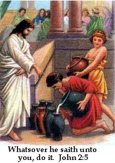 ruly revealing in nature. However, Mary was not going to take an implied “no” for an answer. She simply looks at the “servers” and says:
ruly revealing in nature. However, Mary was not going to take an implied “no” for an answer. She simply looks at the “servers” and says:
“Do whatever He tells you” (John 2:5).
Mary knew her Scriptures well; she helped teach them to Jesus. Mary, in her reply, may have been referencing a verse from the Book of Genesis:
“When all the land of Egypt became hungry and the people cried to Pharaoh for food, Pharaoh said to all the Egyptians: ‘Go to Joseph and do whatever he tells you’” (Genesis 41:55).
What I believe was important about Mary’s reason for wanting Jesus to perform a “sign” before His “time”, and His willingness to ob ey her fully, may have been one of simple logic and survival for Jesus:
ey her fully, may have been one of simple logic and survival for Jesus:
“If momma ain’t happy, ain’t nobody happy!”
Do not forget the Fourth Commandment. Jesus didn’t!!
T
John goes on to report that:
“There were six stone water jars there for Jewish ceremonial washings, each holding twenty to thirty gallons” (John 2:6).
“Twenty to thirty gallons” is a liter al present day translation for the “two or three measures” of Jesus’ day. This vast quantity of wine recalls prophecies of “abundance in the last days” from Jewish Scripture:
al present day translation for the “two or three measures” of Jesus’ day. This vast quantity of wine recalls prophecies of “abundance in the last days” from Jewish Scripture:
“Shouting, they shall mount the heights of Zion, they shall come streaming to the LORD’s blessings: The grain, the wine, and the oil, flocks of sheep and cattle; They themselves shall be like watered gardens, never again neglected” (Jeremiah 31:12);
“Yes, days are coming—oracle of the LORD—When the one who plows shall overtake the one who reaps and the vintager, the sower of the seed; The mountains shall drip with the juice of grapes, and all the hills shall run with it. will restore my people Israel, they shall rebuild and inhabit their ruined cities, Plant vineyards and drink the wine, set out gardens and eat the fruits.” (Amos 9:13–14).
With this “first sign”, the changing of the water to wine, Jesus is replacing the “Jewish ceremonial washings” with His divine body, blood, soul, and divinity washing away all affects of original sin. This event also presented the initial revealing – – the initial revelation – – of Jesus’ divine nature and authority at the outset of His public ministry.
Jesus’ action in this reading points to the “wine of the new covenant” and the “bread of life” He establishes in the “Last Supper” an d in our present Eucharist. It also points to the Messianic banquet which Jesus personally will host at the end of time. (Behold the Lamb of God … Hapy are those invited to the marriage supper of the Lamb!)
d in our present Eucharist. It also points to the Messianic banquet which Jesus personally will host at the end of time. (Behold the Lamb of God … Hapy are those invited to the marriage supper of the Lamb!)
The miracles of Jesus’ public ministry – – His “signs” – – demonstrate the power of God’s love and mercy for His people. God’s kindness knows no limits! And the ultimate expression of His love is revealed in the person of His Son, our Lord – – Jesus Christ. He became flesh for OUR sake; He died for OUR redemption; He rose from the dead for OUR glorification!!
T
John ends his Gospel today by going to the beginning: the beginning of Jesus’ “signs”, the beginning of His revealed “glory”, the beginning of His public ministry, and the beginning of His disciples truly believing in Him as the true promised Messiah:
“Jesus did this as the beginning of His signs in Cana in Galilee and so revealed His glory, and His disciples began to believe in Him” (John 2:11).
God reveals His “glory” in the most unlikely places: in a stable at Bethlehem, at a wedding party in Cana, in the muddy waters of the Jordan River, and on a blood stained cros s outside the walls of Jerusalem. Jesus’ first public miracle – – His first “sign” – – was performed at the confident “invitation” of His mother. In doing as His mother requested of Him, Jesus blessed a young couple, bringing JOY to their wedding feast: first, by His presence, and second, by His surprising response to Hhis mother’s concern, saving them from an embarrassing situation.
s outside the walls of Jerusalem. Jesus’ first public miracle – – His first “sign” – – was performed at the confident “invitation” of His mother. In doing as His mother requested of Him, Jesus blessed a young couple, bringing JOY to their wedding feast: first, by His presence, and second, by His surprising response to Hhis mother’s concern, saving them from an embarrassing situation.
Changing water into wine was a remarkable act of kindness; but saving the best to last was unheard of in Jesus’ day. In Jewish Scripture (our Old Testament) wine was often seen as a gift an d symbol of God’s blessing (cf., Deuteronomy 7:13; Proverbs 3:10, Psalm 105). With Jesus miraculously producing 180 gallons or so of the best wine possible, and many times more than what actually was needed for the feast, He showed the superabundance of the blessings He Himself came to offer to All “Israel”, to ALL peoples.
d symbol of God’s blessing (cf., Deuteronomy 7:13; Proverbs 3:10, Psalm 105). With Jesus miraculously producing 180 gallons or so of the best wine possible, and many times more than what actually was needed for the feast, He showed the superabundance of the blessings He Himself came to offer to All “Israel”, to ALL peoples.
What other signs will Jesus go on to do during His public Ministry? Well, now would be a good time to list the seven “signs” John reveals through his Gospel:
-
The first sign is the transformation of water into wine at Cana (Jn 2:1–11); this represents, as I mentioned earlier, the replacement of the Jewish ceremonial washings and symbolizes the entire creative and transforming work of Jesus.
-
The second sign, the cure of the royal official’s son (Jn 4:46–54) simply by the word of Jesus at a distance, signifies the power of Jesus’ life-giving “Word”.
-
The third sign, the cure of the paralytic at the pool with five porticoes in John 5, continues the theme of water offering newness of life. In the preceding chapter, to the woman at the well in Samaria Jesus had offered living water springing up to eternal life, a symbol of the revelation Jesus brings. Here Jesus’ life-giving “Word” replaces the water of the pool which failed to bring life.
-
John 6 contains two signs: the multiplication of loaves and the walking on the waters of the Sea of Galilee. These signs are related to the “crossing of the Red Sea” and the manna” of the first exodus, manifesting a new exodus in process. The multiplication of the loaves anticipates the future revelation of God in Jesus which the bread of life is His visible “sign” which we call the “Eucharist”.
-
The sixth sign is presented in John 9, the sign of the young man born blind whom Jesus heals. This is a narrative illustration proclaiming the triumph of light over darkness. Remember, this event takes place in the Temple during the Feast of the Tabernacles (aka, the Feast of Lights) at which there were a multitude of candelabras lighted throughout the “Holy Place”. Jesus is presenting Himself as the Light of the Temple, and of the world. The young man had been given his sight by Jesus. This “sign” was an object lesson, revealing the divine power of Jesus to give light to the eyes, and at the same time, subtly revealing the spiritual blindness of the Pharisees and Levites attending to the Menorah.
-
And finally, the seventh sign, the raising of Lazarus in John 11, is the climax of signs. Lazarus is presented as a token of the real, spiritually alive, life which Jesus, THE Resurrection and THE Life, who will now ironically be put to death because of His gift of life to Lazarus, desires to give ALL to those believing in Him then, and after He was seen raised from the dead. Notice the irony of Jesus raising Lazarus and then enduring His own death in place of Lazarus.
John’s purpose in describing these seven signs in their unique order is clearly expressed in what some bible scholars say was the “original” ending of his Gospel, at the end of Chapter 20. Besides these seven just described:
“Jesus did many other signs in the presence of [His] disciples that are not written in this book. But these are written that you may [come to] believe that Jesus is the Messiah, the Son of God, and that through this belief you may have life in His name” (John 20:31).
Amen!! Amen!!
T
In the Church’s lit urgical history, the “wedding feast at Cana” is closely associated with the “adoration of the child Jesus by the Magi” and the “Baptism of our Lord Jesus Christ”. The “sign” Jesus performs at the wedding feast is an “epiphany” (manifestation) of Jesus’ divinity to be celebrated.
urgical history, the “wedding feast at Cana” is closely associated with the “adoration of the child Jesus by the Magi” and the “Baptism of our Lord Jesus Christ”. The “sign” Jesus performs at the wedding feast is an “epiphany” (manifestation) of Jesus’ divinity to be celebrated.
With these epiphanies in mind, awareness of Jesus’ Passion and death looming future on the Holy Cross is ever present in John’s Gospel. Even in today’s narrative of Jesus’ “first sign”, the language used by John anticipates Jesus’ future Passion. When Jesus says to His “mother” that “His hour has not yet come”, Jesus protests against her wishes in words John used again when describing Jesus’ “Last Supper” with His disciples in John 13:1. When introducing the story of Jesus washing His disciples’ feet [also only found in John’s Gospel], John writes that Jesus knew His “hour had come”. Per John, Jesus is very much in command and extremely aware of ALL that is to happen to Him, from the very beginning.
Throughout John’s Gospel, Mary is never mentioned by name, but is referred to instead as “the mother of Jesus”. Mary is overridingly influential in Jesus’ first “sign”. She will never abandon her Son, even being present at Jesus’ Crucifixion. Mary was (and still is) a faithful and constant witness to the final manifestation – – “sign” and epiphany – – of Jesus’ divinity.
John’s Gospel describes seven “signs” indicating Jesus’ true divine nature and identity to His disciples. He never speaks of these “sign s” as miracles because their importance is not in the deed – – the action – – which Jesus performs, but instead in what these deeds indicate in regard to Jesus’ true nature and identity. In today’s reading, Jesus’ disciples are said to “begin to believe”. However, no mention is made as to whether the other wedding guests are even aware of what has happened. (But, they thought the wine was heavenly in deed!)
s” as miracles because their importance is not in the deed – – the action – – which Jesus performs, but instead in what these deeds indicate in regard to Jesus’ true nature and identity. In today’s reading, Jesus’ disciples are said to “begin to believe”. However, no mention is made as to whether the other wedding guests are even aware of what has happened. (But, they thought the wine was heavenly in deed!)
Here, at the beginning of Jesus’ public ministry, John’s Gospel seeks to establish that Jesus is going to re-define and fulfill God’s promise to “Israel”. Jesus is establishing the New Covenant promised to the  prophets. A hint about what this New Covenant will be like is made evident in His deed – – the action Jesus performs. Asked to do something about the awkward situation that a lack of wine at the wedding feast would create, Jesus’ miraculous “sign” produces vast quantities of wine: six jars overflowing with over 180 gallons of superior wine.
prophets. A hint about what this New Covenant will be like is made evident in His deed – – the action Jesus performs. Asked to do something about the awkward situation that a lack of wine at the wedding feast would create, Jesus’ miraculous “sign” produces vast quantities of wine: six jars overflowing with over 180 gallons of superior wine.
This overflowing response to a simple human request is a vision for us – – a “sign” – – about the vast abundance of God’s kingdom. It challenges us to respond generously when confronted with our needs, and others’, today. Responding as best as we can, fully confident that, like the mother of Jesus, God can transform our efforts, brings the Kingdom of God to fulfillment among us here and now!
T
We![]() ddings are magnificent and breathtaking celebrations. We go out of our way to make the occasion festive and extraordinary. People work hard to please one another with a special kind of JOY. What better image of the Kingdom of God can there be than
ddings are magnificent and breathtaking celebrations. We go out of our way to make the occasion festive and extraordinary. People work hard to please one another with a special kind of JOY. What better image of the Kingdom of God can there be than a wedding feast! Wedding celebrations are not an everyday occurrence. ut we can anticipate the Kingdom of God each and every day through our kindness, attention, and care to one another’s needs.
a wedding feast! Wedding celebrations are not an everyday occurrence. ut we can anticipate the Kingdom of God each and every day through our kindness, attention, and care to one another’s needs.
Reflect about weddings and other feasts and HOW they are used as images in Holy S cripture for the Kingdom of God. Consider how these festive occasions are images of God’s tremendous, overflowing, love for us – – and examples of how we can show our love for one another. Think about Mary’s attentiveness to the needs of the wedding hosts, and about Jesus’ response to His mother’s request. What can you learn from today’s Gospel story? Reflect on, and consider ways – – actions or deeds – – in which you might show these same sort of generous and loving values in your daily life. Create your own “sign” for God’s plan in your life and for His kingdom on earth!!
cripture for the Kingdom of God. Consider how these festive occasions are images of God’s tremendous, overflowing, love for us – – and examples of how we can show our love for one another. Think about Mary’s attentiveness to the needs of the wedding hosts, and about Jesus’ response to His mother’s request. What can you learn from today’s Gospel story? Reflect on, and consider ways – – actions or deeds – – in which you might show these same sort of generous and loving values in your daily life. Create your own “sign” for God’s plan in your life and for His kingdom on earth!!
ТТТ
Reflecti on Prayer:
on Prayer:
“Prayer for Generosity”
(St. Ignatius of Loyola)
“Eternal Word, only begotten Son of God,
Teach me true generosity.
Teach me to serve you as you deserve.
To give without counting the cost,
To fight heedless of wounds,
To labor without seeking rest,
To sacrifice myself without thought of any reward
Save the knowledge that I have done your will.
Amen.”
ТТТ
















































































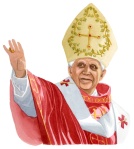



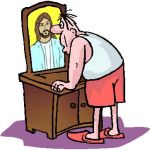


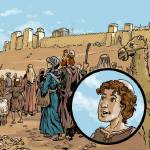















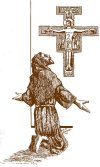
![06-07-buildingrelationships[1]](https://sfodan.files.wordpress.com/2012/12/06-07-buildingrelationships1.jpg?w=227&h=300)
















